The Friends of the Wildflower Garden, Inc.
Plants of the Eloise Butler Wildflower Garden
The oldest public wildflower garden in the United States
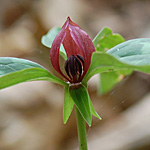
Common Name
Prairie Trillium (Red Trillium, Reflexed Trillium, Bloody Butcher)
Scientific Name
Trillium recurvatum L.C.Beck
Plant Family
Lily (Liliaceae)
New - Bunchflower (Melanthiaceae)
Garden Location
Woodland
Prime Season
Early to Late Spring
Prairie Trillium is an erect perennial with an unpleasant odor, stems smooth, light reddish-green, up to 16 inches high. The stem is an above ground leafless portion (called a 'scape') of the underground rhizome. Typically the upper stem will remain green and lower section will have more reddish tones.
Leaves: In the true trilliums the leaf like parts are actually floral bracts just below the flower base. They are of course much larger than the normal small bracts that you see on most plants, but they are equipped to fulfill the function of a leaf. These bracts are 3 to 4 inches long, 1/2 as wide, tapering to distinctive 1/2 to 1 inch stalks; they are usually mottled dark green-light green on the top side, paler and not mottled on the underside. The bracts have smooth margins, no hair and parallel veins.
Flowers: The inflorescence is a solitary stalkless flower on the scape top, which maintains it's reddish brown petals in an erect position, not spreading, curving inward to touch at the tips and with a claw shape at the base. They also are without a twist. Sepals are green and shorter than the petals and hang down from the flower head beneath the bracts, not on top of the bracts. There are 6 stamens with slender filaments that are dark purple, and with dark purple anthers that curve inward toward each other to cover the ovary, like fingertips touching to make a rounded closed shape. The ovary is composed of 3 united carpels, weakly 6-angled, green with purple touches. The style is short with 3 stigmas that are erect with tips diverging to recurving.
Fruit: The flower matures to an oval fleshy berry, greenish to white, six-angled like the ovary and containing many seeds. Read Eloise Butler's notes in the bottom section of this page. Trilliums are tedious to start from seed as they must have a cold moist period, followed by a warm moist period, followed by another cold moist period, each period of at least 60 to 90 days. Planted in soil, they will thus germinate in the 2nd Spring. Then they will take 3 to 5 years before they flower.
Habitat: Prairie Trillium grows from rhizomes and grows best in light to dappled shade in rich soil with good but not excessive moisture. Plants take a number of years of growth before flowering. The name Prairie Trillium is not the most descriptive since this is a woodland plant, but it tolerates more sun and drier conditions that the other Trilliums. The root system does not spread aggressively.
Names: The genus name Trillium, is derived from the Latin trilix, meaning 'triple' and referring to the flowers having parts of three. The species name recurvatum, refers to the downward reflexed sepals which are a distinguishing characteristic.
The author name for the plant classification from 1826 - ‘L.C.Beck’ refers to Lewis Caleb Beck (1798-1853) American professor of botany, chemistry, natural history and pharmacy at various colleges between 1824 and 1853. Several of his publications were Natural History of the State of New York (1842) and Botany of the United States North of Virginia (1848).
New Family: There is a movement among botanists to segregate the Trilliums and a few other genera out of the Liliaceae Family and into the Melanthiaceae. The U of M Herbarium has made this change on their Minnesota checklist but Flora of North America has not yet published this.
Comparisons: Both Trillium sessile (Toadshade) and Trillium cuneatum (Sweet Betsy) have a similar appearing bract but much more oval, and a similar color flower, but their bracts do not have stalks and their flowers have petals that are erect or spreading but not curving inward.
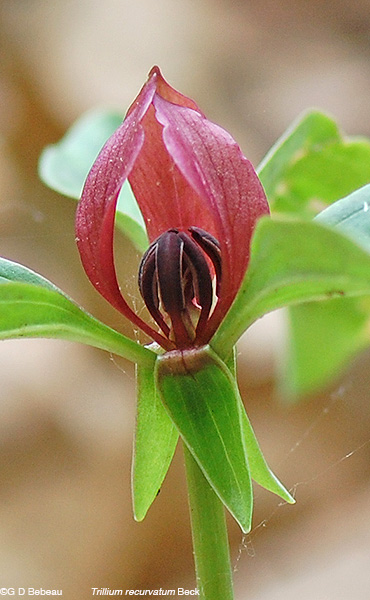
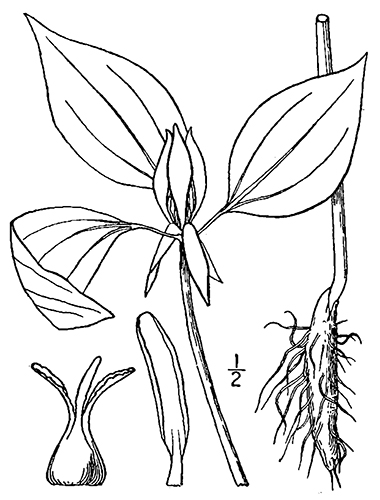
Above: Prairie Trillium is similar to Toadshade and Sweet Betsy. The differences are in the stalked bracts, the reflexed sepals and inward curve of the petals and stamens. Plants take a number of years of growth before flowering. Drawing from Britton, N.L., and A. Brown. 1913. An illustrated flora of the northern United States, Canada and the British Possessions. 3 vols. Charles Scribner's Sons, New York.
Below: 1st photo - The bracts are stalked, long and only 1/2 as wide. 2nd photo - The petals remain closed at the tip.
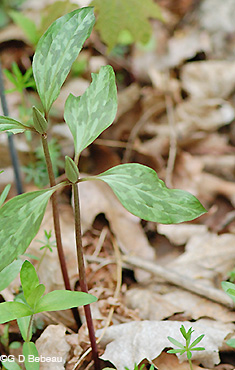
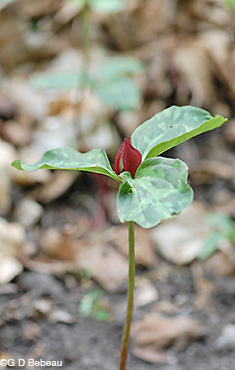
Below: 1st photo - The tall scape with relatively smaller bracts is another distinguishing characteristic. 2nd photo - The underside of the leaf is paler in color and not mottled like the upper side.
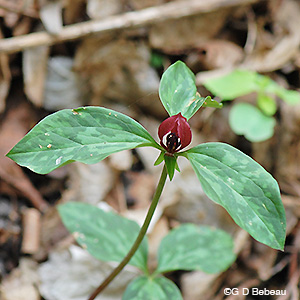
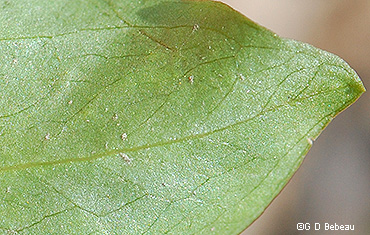
Notes: Prairie Trillium is not indigenous to the Garden. Eloise Butler first recorded planting Prairie Trillium on Oct. 6, 1913 with 12 plants obtained from Gillett's Nursery in MA, six more on Oct. 12, 1918 and 12 on Oct. 1, 1920. It was present at the time of Martha Crone's 1951 Garden Census - she planted it in 1946, '53, and '56. Susan Wilkins planted 20 in 2020. It is not native to Minnesota but is native to a number of states east and south from Minnesota. It is not found in Canada. Four Trilliums are considered native to Minnesota: T. cernuum, T. flexipes, T. grandiflorum and T. nivale.
Eloise Butler wrote: Trilliums are closely related to the lilies. All have a thick underground stem, bearing a single aerial stem, which supports a whorl of three large leaves varying somewhat in size and shape in different species. Above the leaf whorl arises the lovely flower, with or without a stalk; erect or drooping; white, red, purple or pink striped, according to the species. The flower is also on the plan of three green sepals, three colored petals, six stamens in two rows and one pistil made up of three united carpels. The name trillium probably comes from the three leaves. The plant has a number of local names - wake robin, bath flower and “way down east.” Published May 21, 1911, Minneapolis Sunday Tribune.
Return to -- Site Plan/Archive Index --or-- List of Common Plant Names -- or -- List of Scientific Names -- or --Home Page - - - Back to top.
References: Plant characteristics are generally from sources 1A, 32, W2, W3, W7 & W8 plus others as specifically applied. Distribution principally from W1, W2 and 28C. Planting history generally from 1, 4 & 4a. Other sources by specific reference. See Reference List for details.
 Identification booklet for most of the flowering forbs and small flowering shrubs of the Eloise Butler Wildflower Garden. Details Here.
Identification booklet for most of the flowering forbs and small flowering shrubs of the Eloise Butler Wildflower Garden. Details Here.
©2014
Friends of the Wildflower Garden, Inc. Text and photos are by G. D. Bebeau unless otherwise credited. "www.friendsofeloisebutler.org"
101520